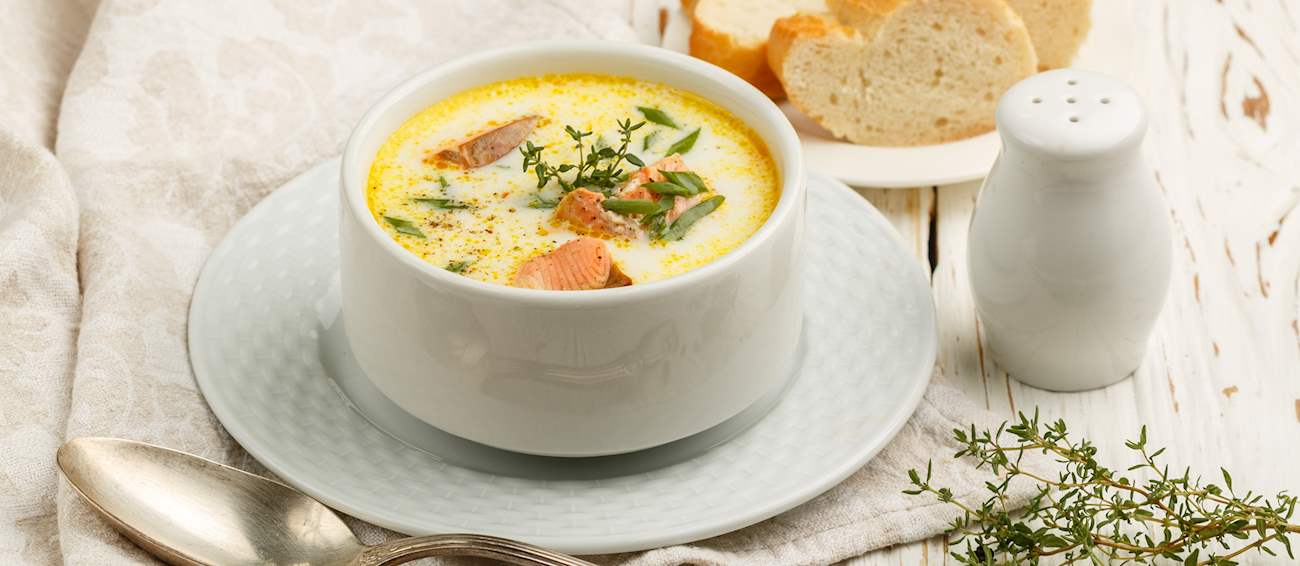MAIN INGREDIENTS
Loimulohi is a traditional method of preparing salmon or rainbow trout. The fish is smoked on a wooden plank that's placed vertically over an open fire. Before the process, the salmon is usually seasoned with sea salt and drizzled or brushed with lemon juice, honey, or juniper berries.
The cooking time depends on the distance from the coals. Once done, the smoky fish can be eaten straight off the plank.
Kalakeitto or fish soup has been a staple of traditional Finnish cuisine for a long time. Although there are numerous ways to prepare this classic Finnish specialty, it typically consists of cleaned and filleted fish chunks and diced vegetables that are simmered in a rich, buttery fish broth.
Carrots, potatoes, onions, and leeks are among the most common vegetables used for the soup’s preparation, while the choice of fish includes salmon, rainbow trout, vendace, pike, perch, zander, or burbot. Traditionally, the soup is enhanced with the addition of butter and cooking cream (ruokakermaa), and it is usually flavored with dill, allspice, bay leaves, salt, and pepper.
The cinnamon roll or kanelbulle is a famous Swedish pastry made with yeasted, butter-rich, sweetened, and cardamom-flavored dough and has a cinnamon, butter, and sugar filling. Traditionally, kanelbulle will also have pearl sugar on top, although some variants can have either cardamom sugar or slivered almonds instead.
Cinnamon rolls are typically associated with fika, a well-established Swedish coffee-and-cake form of socializing. Although the origin of these tasty swirls is still subject to considerable debate, the pastry has its own day in Sweden – October 4th, known as Cinnamon Roll Day.
MOST ICONIC Kanelbulle
View moreOne of the most popular Swedish desserts is a rich chocolate cake known as kladdkaka. This classic Swedish creation combines eggs, cocoa (or chocolate), butter, sugar, and flour into a dense and luscious dessert. During baking, the cake should always remain moist in the center, while the outer layer is transformed into a thin, crunchy coating.
Since the cake is incredibly dense, and typically heavy on the bitter chocolate or cocoa, it is usually dusted with a delicate layer of powdered sugar, and traditionally served with a dollop of ice cream or whipped cream on the side. It is one the most beloved Swedish desserts, typically enjoyed during fika, a traditional Swedish coffee break.
Gravlax is a Scandinavian dish consisting of raw, salt-cured salmon that is traditionally seasoned with dill. Originally, the dish was made by fishermen who used to bury the salt, sugar, and dill-rubbed salmon above the line of high tide and leave it to ferment.
At the time, it was characterized by its pungent flavor and odor, but today, gravlax is cured under refrigeration. The name gravlax comes from a combination of two words, grav, meaning buried, and lax, meaning salmon, referring to the original method of production.
MAIN INGREDIENTS
Lohikeitto is a creamy Finish salmon soup, similar to laxsoppa in Sweden. Apart from chunks of salmon fillet, it traditionally incorporates diced potatoes and carrots cooked in a flavorful, buttery broth infused with fish stock and cream.
This comforting winter dish is generously seasoned with dill and served alongside buttered rye bread or lemon wedges.
Sake nigiri sushi is a Japanese type of nigiri sushi, with origins in Norway. It consists of hand-pressed sushi rice that's topped with slices of salmon. The dish has a soft texture and a clean finish that makes it good for sushi newcomers, although the flavor can be a bit fishier than maguro (tuna) nigiri sushi.
Traditionally, this type of sushi is eaten by hand in a single bite. It's usually accompanied by soy sauce, wasabi, or pickled ginger (gari) on the side.
OTHER VARIATIONS OF Sushi
MAIN INGREDIENTS
Jordgubbstårta is a traditional strawberry cake originating from Sweden. It usually consists of five parts: sponge cake (flour, sugar, eggs, cornstarch, vanilla); lemon syrup (lemon juice, water, sugar); pastry cream (eggs, sugar, vanilla, flour, butter, milk); mascarpone whipped cream (mascarpone cheese, crème fraiche, sugar, vanilla), and a garnish of fresh strawberries.
In order to assemble the cake, the sponge cake is brushed with lemon syrup, topped with pastry cream and quartered strawberries, and then with whipped cream. The process is repeated two more times, and the cake is then covered with mascarpone whipped cream and the remaining strawberries.
Köttbullar are famous Swedish meatballs with a crispy brown exterior, and light, airy and tender texture on the interior. The original recipe for the dish first appeared in Cajsa Warg's 1754 cookbook. The meatballs usually consist of beef mixed with pork or veal, and the combination is typically seasoned with onions, salt, pepper, and allspice.
The mixture is shaped into small, round meatballs and browned in hot butter. This dish is traditionally accompanied by lingonberry sauce, creamy mashed potatoes, and a thick gravy on the side, although lighter side dishes such as cucumber salad or red cabbage are also quite popular.
MOST ICONIC Köttbullar
View moreThe epitome of a cozy Sunday breakfast in Denmark is a crispy sweet treat known as Danish pastry. It is made with laminated dough, where the dough is repeatedly covered with butter and folded over itself. The result is a creation that is quite similar to puff pastry.
The dough is shaped into different forms and filled with flavorful, creamy fillings. Traditional fruit fillings such as apple and raspberry, vanilla custard, and almond paste are Danish favorites, but due to its popularity, the fillings are usually region-specific.
MOST ICONIC Wienerbrød
View moreTasteAtlas food rankings are based on the ratings of the TasteAtlas audience, with a series of mechanisms that recognize real users and that ignore bot, nationalist or local patriotic ratings, and give additional value to the ratings of users that the system recognizes as knowledgeable. For the “Top 100 Northern European Foods” list until February 16, 2025, 9,435 ratings were recorded, of which 7,987 were recognized by the system as legitimate. TasteAtlas Rankings should not be seen as the final global conclusion about food. Their purpose is to promote excellent local foods, instill pride in traditional dishes, and arouse curiosity about dishes you haven’t tried.







































































































